

Table of contents
- Location
- substrate
- Pour
- Fertilize
- outdoor
- repot
- hibernate
- Cut
- multiply
- side shoots
- seed
- Typical care mistakes, diseases and pests
- scale insects
- fungal infection
- rot
- Caution: Toxic
The Madagascar palm is visually reminiscent of a palm tree, but it is a succulent and one of the easy-care plants. If its low demands are met, it rewards the effort with an unusual look and even flowers. This makes the houseplant ideal for beginners and anyone without a green thumb. However, the appropriate knowledge of the culture must be available.
Location
The Madagascar palm comes - as the name suggests - from Madagascar and reaches amazing heights of up to eight meters. It will not take on such dimensions in the living room or conservatory, but it needs the same conditions. This means that it should be as sunny and warm as possible.
Above all, the relationship between light and heat must be right. The lighter the Madagascar palm, also known as thick-footed, is, the higher the temperature must be. If it is in the light shade, it should be a little cooler. Among other things, this is of decisive importance for the prevention of diseases and pest infestations. A location on the south side close to the window is therefore optimal. On the other hand, a place directly above the heater is unfavorable, provided that the plant is not in the blazing sun at the same time or is illuminated with a plant lamp.
substrate
The easiest choice initially is special substrate for cacti and succulents. However, in the case of the Madagascar palm, this requires more frequent watering, fertilizing and repotting - so the maintenance effort is constantly increasing. Mixtures that meet the following requirements are more suitable:
- Permeable and loose, not tending towards compaction
- Moderately water retaining
- Nutritious
These conditions can be achieved if potting soil or potting soil is mixed with sand, coconut fiber or cactus soil and thus loosened up.
Pour
As a succulent, the Madagascar palm is frugal when it comes to watering - but due to its origin it has a special feature. So the stubborn is dependent on dry and rainy seasons in order to be able to thrive and grow vigorously.

Unfortunately, this is not so easy to pin down to the seasons. Instead, the madagascar palm shows when it is preparing for a dry season and when it needs a rainy season. When she sheds her leaves, the dry phase begins. This is only watered very sparingly, i.e. watered just enough so that the substrate does not dry out completely or even crack. If the thick-foot forms new leaves, the soil can be kept evenly moist.
In addition, the following points are crucial when watering the Madagascar palm:
- Avoid extremes such as dryness and waterlogging
- Use low-lime, soft water
- Do not use cold water for watering
Tip:
If the tap water is very hard, rainwater, untreated pond or aquarium water as well as filtered or stagnant tap water can be used.
Fertilize
For a succulent, the Madagascar palm has a comparatively high nutrient requirement. However, this also varies depending on the dry and rainy seasons, which can only be simulated in the living room by watering.
During the dry phase, when the thick-foot sheds its leaves, it can absorb only a few nutrients. The substrate is then completely sufficient for the supply and no additional fertilization is required. If the leaves start to sprout again, fertilizer should be used. Cactus fertilizers or a liquid complete fertilizer in small quantities are suitable. The additional nutrient supply can begin four weeks after the first visible budding and is continued for four to six months. The Madagascar palm then goes back into the dormant phase, in which fertilization is stopped and watering is reduced.
outdoor
The Madagascar palm can spend the summer outdoors, as long as the temperature is above 15°C at night. For young plants, a minimum consistent temperature of 18°C is safer. Of course, the thickfoot should not be planted outdoors, but should continue to be cultivated in the bucket. In addition, the following factors should be considered when choosing the location:
- As sunny as possible, direct sunlight is ideal
- Protected from cold wind and heavy rain
- Warm, for example in a corner or near a wall
If a drop in temperature is to be expected, the Madagascar palm should be brought indoors.
Tip:
If you don't want to constantly move the succulent, you can also treat it to a place by the open window in summer.
repot
How often repotting is necessary depends on the one hand on the chosen substrate. With cactus soil, a change is necessary every two years at the latest. With potting soil or potting soil, it can also be three or four years between repotting.
On the other hand, the size of the Madagascar palm is of course also a decisive factor. If the planter has roots, a larger pot should be chosen. It is sufficient to choose the vessel one size larger. In this way, it can also be watered more sparingly, since less substrate has to be completely moistened.
Soil change or repotting should take place at the start of the rainy season, i.e. when the leaves sprout again. Gloves must be worn during the measure to avoid skin contact in the event of damage to the plant and escaping plant sap.
Tip:
The prickly trunk of the Madagascar palm can become a problem when repotting. To avoid injury, it can be wrapped in paper or fitted with Styrofoam sheets.
hibernate

The Madagascar palm does not need a separate hibernation, but the already mentioned dry season. This usually falls in the cold months, but can also occur in summer. This depends on the plant and can only be influenced from the outside to a limited extent. So a closer look is required here. However, a change of location is not necessary. Only the watering has to be reduced and the fertilization stopped. The Madagascar palm indicates the end of the dormant phase by sprouting new leaves. At this point it can also be repotted.
Cut
The Madagascar palm does not require pruning and usually does not tolerate it well. Only damaged or diseased leaves should be shortened or removed.
A clean and sharp cutting tool, i.e. scissors or a knife, is used for this. In order to protect the skin from direct contact with escaping plant sap, gloves should be worn and the cutting tool should be thoroughly cleaned afterwards.
multiply
The Madagascar palm can be propagated by seeds or side shoots. With both variants, however, patience is required, since the stubborn one only develops flowers and side shoots after several years.
side shoots
If you want to try it, you should prefer the propagation of the Madagascar palm over side shoots. This way is faster and requires less effort. The procedure is as follows:
- The side shoot is cut off close to the mother plant with a sharp and clean knife when it is strong and at least five, better ten centimeters long.
- The cut is provided with rooting powder and then left to dry for a day. Drying reduces the risk of rot.
- The shoot is then placed two to three centimeters deep in potting soil or the substrate mixture of the mother plant. The soil should be kept moist but not wet.
- The planter must be warm and bright. In order to keep the effort for watering low and to promote the rooting of the shoot, the pot can be covered with foil or a hood or placed in a greenhouse.
Propagation is visibly successful when the shoot grows and develops new leaves.
seed
If you decide to propagate by seeds, you have to put in a little more effort and proceed as described below:
- If flowers form, they are pollinated with a brush. Even if the Madagascar palm is outdoors, pollination by insects is not guaranteed.
- After successful pollination, seeds form, which can be collected by the thick-footed plant. If they are not to be sown immediately, they can be stored in a dark and dry place.
- For germination, they are placed on potting soil or the substrate mixture described and only lightly covered with it.
- The substrate is well moistened and best sprayed for this purpose.
- Placed in light and at 24 to 30°C, germination takes several weeks. A heatable indoor greenhouse is ideal as a location for this time. If this is not available, the planter should be covered again to retain heat and moisture.
- When they have reached a height of about ten centimetres, the young plants are separated and repotted and no longer have to be covered. Keeping the substrate moist is still important, especially in the beginning.
Typical care mistakes, diseases and pests
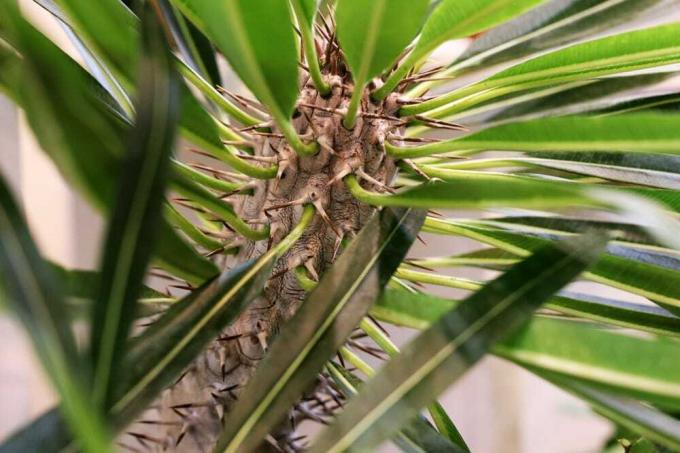
Due to its origin in local areas, the Madagascar palm is rarely attacked by diseases and pests. However, scale insects and fungal infections can occur.
scale insects
Scale insects suck the sap of plants and can cause malformed growth and discoloration. The pests, like their sticky secretion, are clearly visible on the Madagascar palm. However, combating them is relatively easy:
- Thorough rinsing and gentle brushing of the growth
- Use of natural oil-based pesticides
- Release of predators such as ladybugs, lacewings and hoverflies or lacewings
fungal infection
In the event of a fungal infection or the spread of rot, the leaves not only discolour, they also wither and fall off prematurely. The substrate also has a musty, moldy odor and a whitish or gray film may form on it. The fungal spores can also spread in cracks or injuries to the leaves and bark - i.e. not initially found in the substrate. To save the madagascar palm, the following measures are important:
- Remove affected parts of the plant with a sharp knife or scissors and let the interfaces dry
- Immediate and thorough change of the entire substrate
- Regulating the pouring amount
rot
Above all, the rot is due to two typical care mistakes. This can be due to lack of watering as well as pouring to be washed away. Because if the Madagascar palm lacks water, the leaves, trunk and bark become wilted, limp and cracked. Germs can thus spread better. Waterlogging in turn favors rot very directly and especially in the substrate. Other typical mistakes in the culture of the Madagascar palm include:
- Location too dark
- Improper balance between heat and light - for example rather dark but very high temperatures
- ground cold
- Substrate that tends to compact or is poor in nutrients
- Rare watering
- use of hard water
- Lack of compliance with dry phases and rainy seasons
Caution: Toxic
All parts of the Madagascar palm are poisonous, so care should be taken when cutting and the skin should be protected from direct contact with the plant sap. In addition, it should be used in households with small children and animals that come into contact with it when playing or could pick up parts of plants, stand out of reach or dispense with the stubborn foot become.
 Home editorial office
Home editorial office
Learn more about palm trees
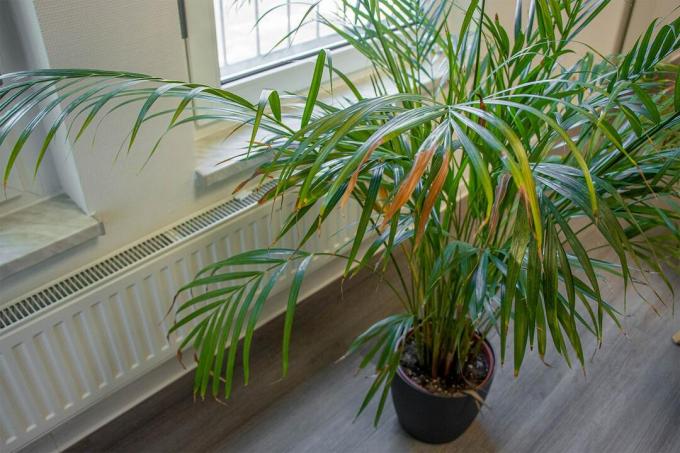
Palm leaves hanging: save yucca & co
Palm trees give the home a southern flair. However, if Yucca & Co. let their leaves droop, their sight is rather desolate. The causes of hanging palm fronds vary. A rescue attempt is always worthwhile.
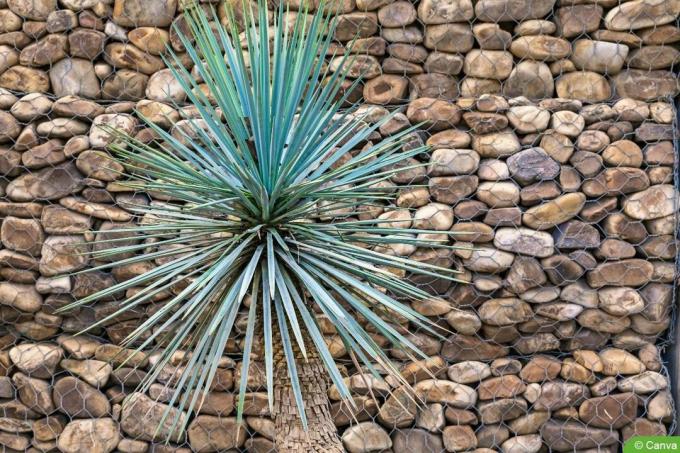
Blue palm lily, Yucca rostrata: 12 tips for care & Co.
The blue yucca (Yucca rostrata) is one of the most fascinating Yucca species. Since it hardly requires any care, it is also suitable for the office. Planted in the garden, it is considered hardy when it is dry.
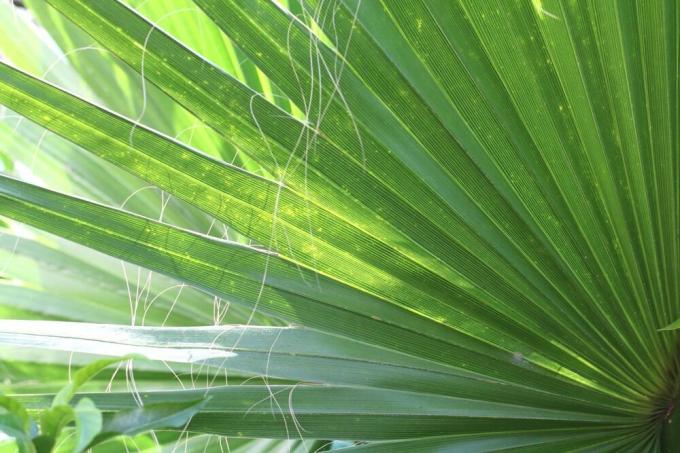
Washington Palm: Care From A-Z | Overwinter Washingtonia robusta
The Washington palm is a decorative plant that can grow to an impressive size. Due to the lack of winter hardiness, the plant is usually kept indoors in this country. When it comes to care, the palm makes certain demands so that healthy development can occur.

Areca palm, Dypsis lutescens: basics of care
The Areca Palm is a beautiful plant for indoor greenery. When it comes to care and location, the palm has certain requirements, if these are met, the plant will thrive. In order for the plant to grow constantly green, it needs the right lighting conditions.
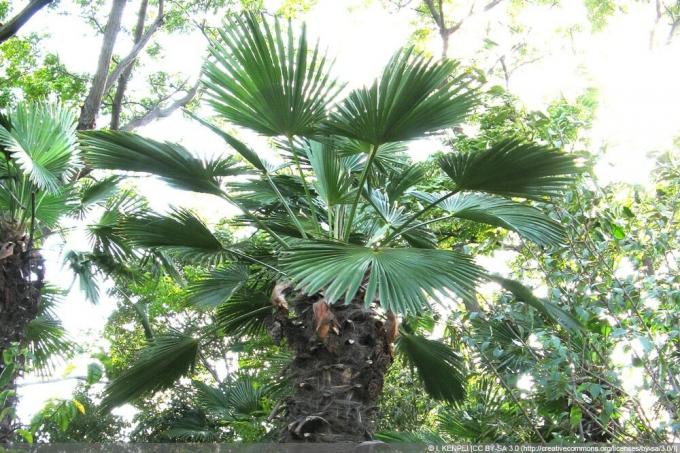
Wagner's hemp palm, Trachycarpus wagnerianus: Care from A-Z
If you want exotic flair in your garden or on your terrace, you can't avoid Wagner's hemp palm. No wonder: the extremely decorative umbrella palm not only looks impressive, but is also very robust. More about this is here.

Candle palm lily, Yucca Gloriosa – Care from A-Z | Is she hardy?
A yucca is better known to most as an exotic houseplant, the candle palm lily (bot. Yucca gloriosa) is also ideal as an outdoor plant, bringing a touch of tropical flair to your garden.
